Design and Implementation of a Novel Single-Driven Ultrasonic Elliptical Vibration Assisted Cutting Device
Abstract
:1. Introduction
2. Design of the Single Driven Ultrasonic Elliptical Vibration Cutting (SDUEVC) Device
2.1. Configuration of the SDUEVC Device
2.2. The Elliptical Trajectory Formation Mechanism
2.3. Finite Element Analysis of the SDUEVC Device
3. Results and Discussion
3.1. Experiment to Test the Vibration Characteristics of the SDUEVC Device
3.2. Cutting Experiments of the Proposed SDUVEC Device
4. Conclusions
Author Contributions
Funding
Conflicts of Interest
References
- Zhang, J.; Cui, T.; Ge, C.; Sui, Y.; Yang, H. Review of micro/nano machining by utilizing elliptical vibration cutting. Int. J. Mach. Tools Manuf. 2016, 106, 109–126. [Google Scholar] [CrossRef]
- Shamoto, E.; Moriwaki, T. Ultaprecision diamond cutting of hardened steel by applying elliptical vibration cutting. CIRP Ann.-Manuf. Technol. 1999, 48, 441–444. [Google Scholar] [CrossRef]
- Brinksmeier, E.; Gläbe, R. Advances in precision machining of steel. CIRP Ann.-Manuf. Technol. 2001, 50, 385–388. [Google Scholar] [CrossRef]
- Zhang, X.; Kumar, A.S.; Rahman, M.; Nath, C.; Liu, K. Experimental study on ultrasonic elliptical vibration cutting of hardened steel using PCD tools. J. Mater. Process. Technol. 2010, 211, 1701–1709. [Google Scholar] [CrossRef]
- Suzuki, N.; Haritani, M.; Yang, J.; Hino, R.; Shamoto, E. Elliptical vibration cutting of tungsten alloy molds for optical glass parts. CIRP Ann.-Manuf. Technol. 2007, 56, 127–130. [Google Scholar] [CrossRef]
- Zhao, H.; Li, S.; Zou, P.; Kang, D. Process modeling study of the ultrasonic elliptical vibration cutting of Inconel 718. Int. J. Adv. Manuf. Technol. 2017, 92, 2055–2068. [Google Scholar]
- Lotfi, M.; Amini, S. FE simulation of linear and elliptical ultrasonic vibrations in turning of Inconel 718. Proc. Inst. Mech. Eng. Part E-J. Process Mech. Eng. 2018, 232, 438–448. [Google Scholar] [CrossRef]
- Zhang, J.; Suzuki, N.; Wang, Y.; Shamoto, E. Fundamental investigation of ultra-precision ductile machining of tungsten carbide by applying elliptical vibration cutting with single crystal diamond. J. Mater. Process. Technol. 2014, 214, 2644–2659. [Google Scholar] [CrossRef]
- Nath, C.; Rahman, M.; Neo, K.S. A study on ultrasonic elliptical vibration cutting of tungsten carbide. J. Mater. Process. Technol. 2009, 209, 4459–4464. [Google Scholar] [CrossRef]
- Nath, C.; Rahman, M.; Neo, K.S. Machinability study of tungsten carbide using PCD tools under ultrasonic elliptical vibration cutting. Int. J. Mach. Tools Manuf. 2009, 49, 1089–1095. [Google Scholar] [CrossRef]
- Xu, W.; Zhang, L.C.; Wu, Y. Elliptic vibration-assisted cutting of fibre-reinforced polymer composites: Understanding the material removal mechanisms. Compos. Sci. Technol. 2014, 92, 103–111. [Google Scholar] [CrossRef]
- Xu, W.X.; Zhang, L.C. Ultrasonic vibration-assisted machining: Principle, design and application. Adv. Manuf. 2015, 3, 173–192. [Google Scholar] [CrossRef]
- Xu, W.X.; Zhang, L.C. Mechanics of fibre deformation and fracture in vibration-assisted cutting of unidirectional fibre-reinforced polymer composites. Int. J. Mach. Tools Manuf. 2016, 103, 40–52. [Google Scholar] [CrossRef]
- Song, Y.C.; Park, C.H.; Moriwaki, T. Mirror finishing of Co–Cr–Mo alloy using elliptical vibration cutting. Precis. Eng. 2010, 34, 784–789. [Google Scholar] [CrossRef]
- Kim, G.D.; Loh, B.G. Direct machining of micro patterns on nickel alloy and mold steel by vibration assisted cutting. Int. J. Precis. Eng Manuf. 2011, 12, 583–588. [Google Scholar] [CrossRef]
- Kim, G.D.; Loh, B.G. Characteristics of elliptical vibration cutting in micro V-grooving with variations of elliptical cutting locus and excitation frequency. J. Micromech. Microeng. 2008, 18, 025002. [Google Scholar] [CrossRef]
- Guo, P.; Ehmann, K.F. Development of a tertiary motion generator for elliptical vibration texturing. Precis. Eng. 2013, 37, 364–371. [Google Scholar] [CrossRef]
- Guo, P.; Ehmann, K.F. An analysis of the surface generation mechanics of the elliptical vibration texturing process. Int. J. Mach. Tools Manuf. 2013, 64, 85–95. [Google Scholar] [CrossRef]
- Zhang, C.; Shi, G.; Ehmann, K.F.; Li, Y. Modeling and simulation of micro-groove topography on cylindrical surface by elliptical vibration-assisted turning. Int. J. Adv. Manuf. Technol. 2016, 86, 1407–1424. [Google Scholar] [CrossRef]
- Yang, Y.; Pan, Y.; Guo, P. Structural coloration of metallic surfaces with micro/nano-structures induced by elliptical vibration texturing. Appl. Surf. Sci. 2017, 402, 400–409. [Google Scholar] [CrossRef]
- Zhou, X.; Zuo, C.; Liu, Q.; Lin, J. Surface generation of freeform surfaces in diamond turning by applying double-frequency elliptical vibration cutting. Int. J. Mach. Tools Manuf. 2016, 104, 45–57. [Google Scholar] [CrossRef]
- Kurniawan, R.; Ko, T.J.; Li, C.P.; Kumaran, S.T.; Kiswanto, G.; Guo, P.; Ehmann, K.F. Development of a two-frequency, elliptical-vibration texturing device for surface texturing. J. Mech. Sci Technol. 2017, 31, 3465–3473. [Google Scholar] [CrossRef]
- Kurniawan, R.; Kiswanto, G.; Ko, T.J. Surface roughness of two-frequency elliptical vibration texturing (TFEVT) method for micro-dimple pattern process. Int. J. Mach. Tools Manuf. 2017, 116, 77–95. [Google Scholar] [CrossRef]
- Zhou, M.; Hu, L. Development of an innovative device for ultrasonic elliptical vibration cutting. Ultrasonics 2015, 60, 76–81. [Google Scholar] [CrossRef] [PubMed]
- Amini, S.; Khosrojerdi, M.R.; Nosouhi, R. Elliptical ultrasonic–assisted turning tool with longitudinal and bending vibration modes. Proc. Inst. Mech. Eng. Part B-J. Eng. Manuf. 2015, 231, 1389–1395. [Google Scholar] [CrossRef]
- Tan, R.; Zhao, X.; Zou, X.; Sun, T. A novel ultrasonic elliptical vibration cutting device based on a sandwiched and symmetrical structure. Int. J. Adv. Manuf. Technol. 2018, 97, 1397–1406. [Google Scholar] [CrossRef]
- Moriwaki, T.; Shamoto, E. Ultrasonic elliptical vibration cutting. CIRP Ann.-Manuf. Technol. 1995, 44, 31–34. [Google Scholar] [CrossRef]
- Huang, W.H.; Yu, D.P.; Zhang, M.; Ye, F.G.; Yao, J. Analytical design method of a device for ultrasonic elliptical vibration cutting. J. Acoust. Soc. Am. 2017, 141, 1238–1245. [Google Scholar] [CrossRef] [PubMed]
- Li, X.; Zhang, D. Ultrasonic elliptical vibration transducer driven by single actuator and its application in precision cutting. J. Mater. Process. Technol. 2006, 180, 91–95. [Google Scholar] [CrossRef]
- Brinksmeier, E.; Gläbe, R. Elliptical vibration cutting of steel with diamond tools. Proc. ASPE 1999, 20, 163–166. [Google Scholar]
- Yin, Z.; Fu, Y.; Xu, J.; Li, H.; Cao, Z.; Chen, Y. A novel single driven ultrasonic elliptical vibration cutting device. Int. J. Adv. Manuf. Technol. 2017, 90, 3289–3300. [Google Scholar] [CrossRef]
- Ma, C.; Ma, J.; Shamoto, E.; Moriwaki, T. Analysis of regenerative chatter suppression with adding the ultrasonic elliptical vibration on the cutting tool. Precis. Eng. 2011, 35, 329–338. [Google Scholar] [CrossRef]
- Shamoto, E.; Suzuki, N.; Hino, R. Analysis of 3D elliptical vibration cutting with thin shear plane model. CIRP Ann.-Manuf. Technol. 2008, 57, 57–60. [Google Scholar] [CrossRef]
- Yang, X.; Liu, Y.; Chen, W.; Liu, J. Longitudinal and bending hybrid linear ultrasonic motor using bending PZT elements. Ceram. Int. 2013, 39, S691–S694. [Google Scholar] [CrossRef]
- Watanabe, Y.; Tsuda, Y.; Mori, E. A study on a transducer-stepped type solid horn system for flexural mode ultrasonic high power transducer with one dimensional construction. Ultrason. Int. 1991, 435–438. [Google Scholar] [CrossRef]
- Parkus, H. Thermoelasticity; Springer: Berlin, Germany, 1976. [Google Scholar]


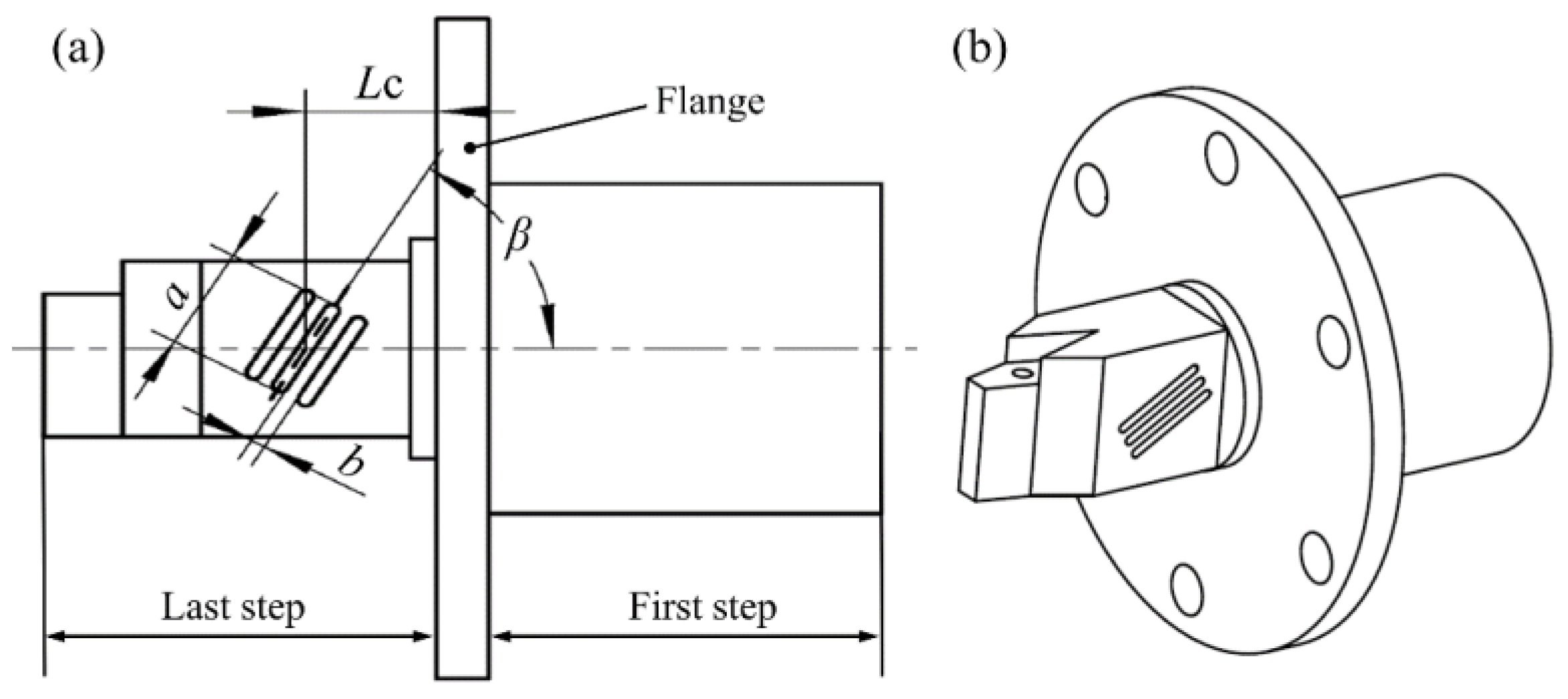
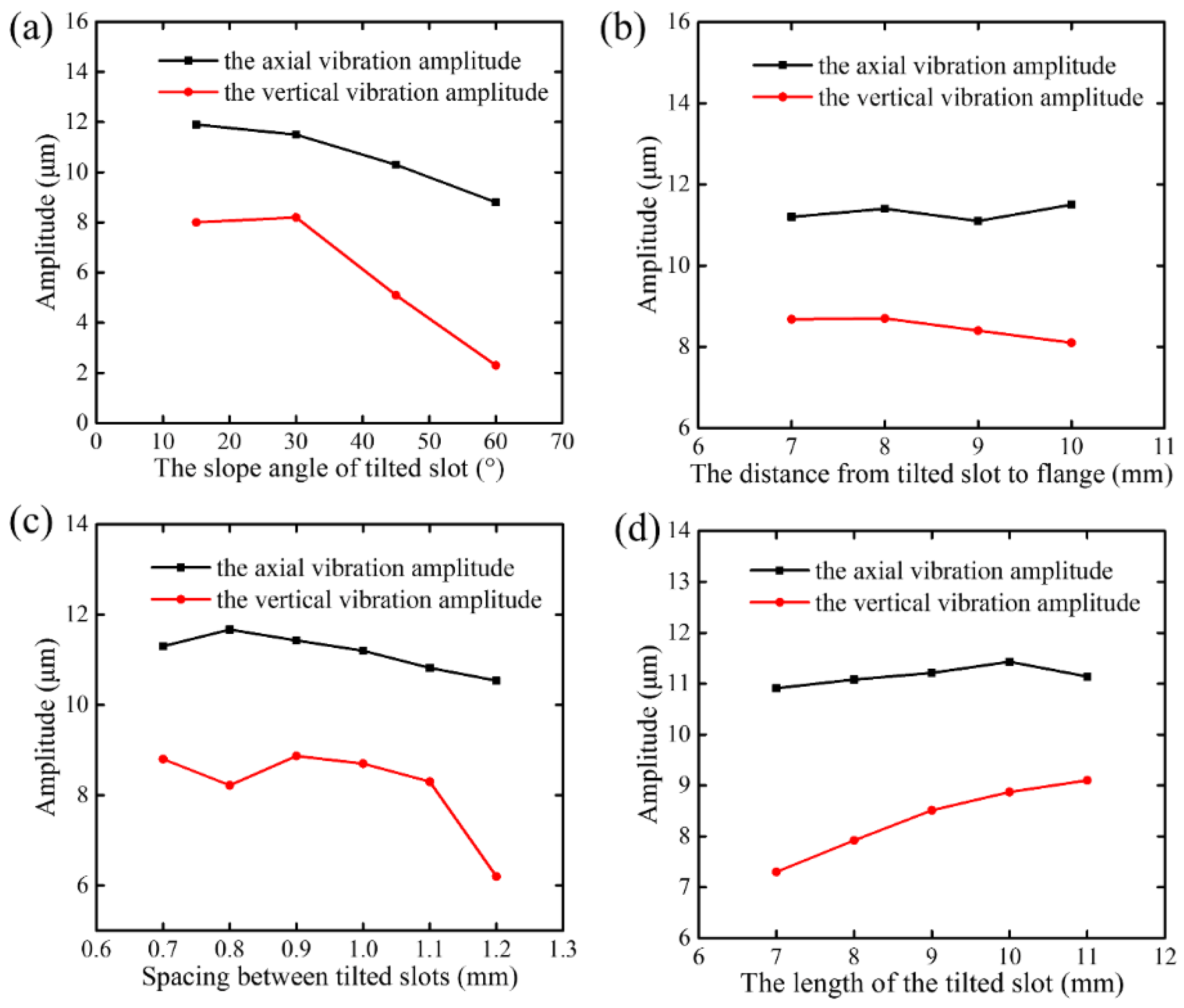

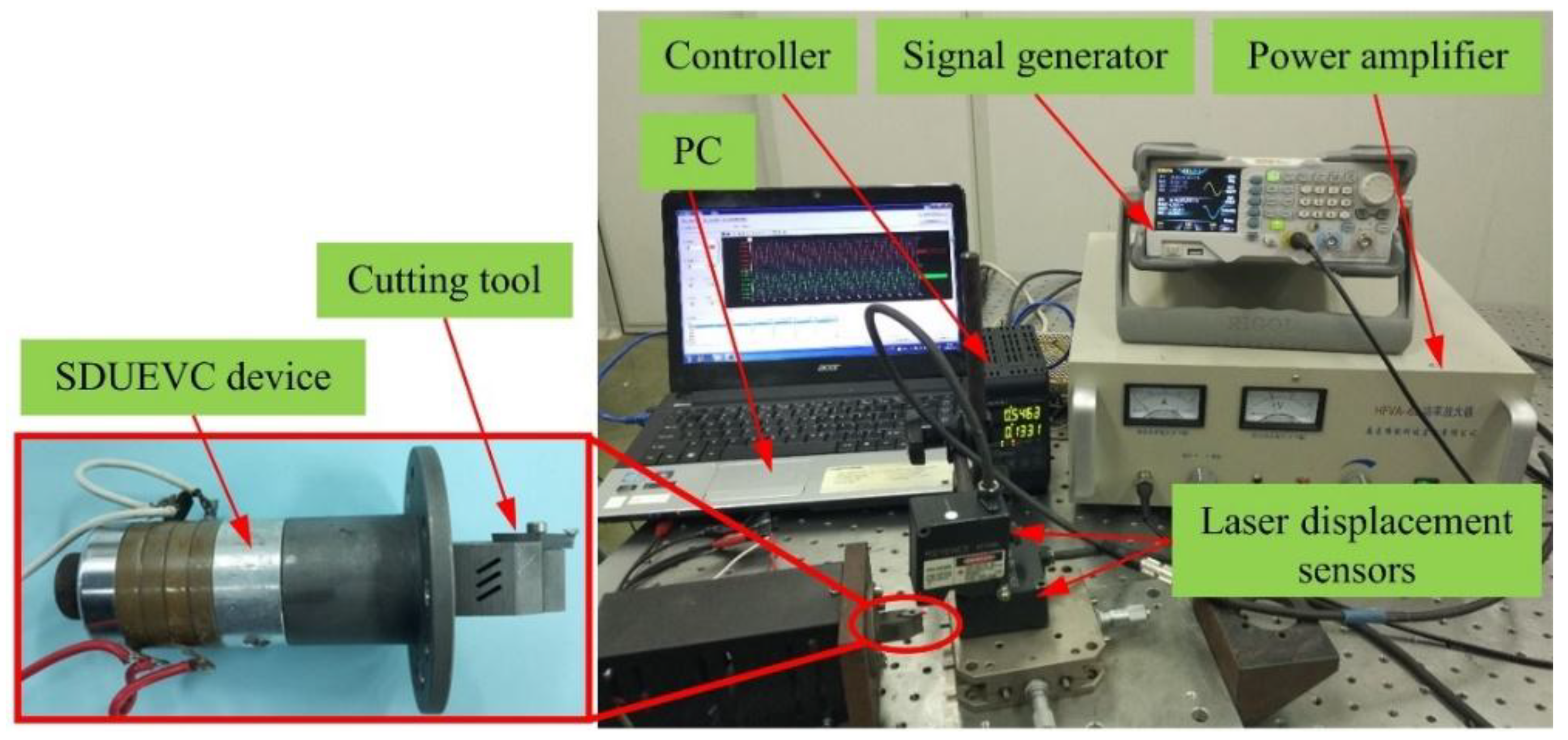
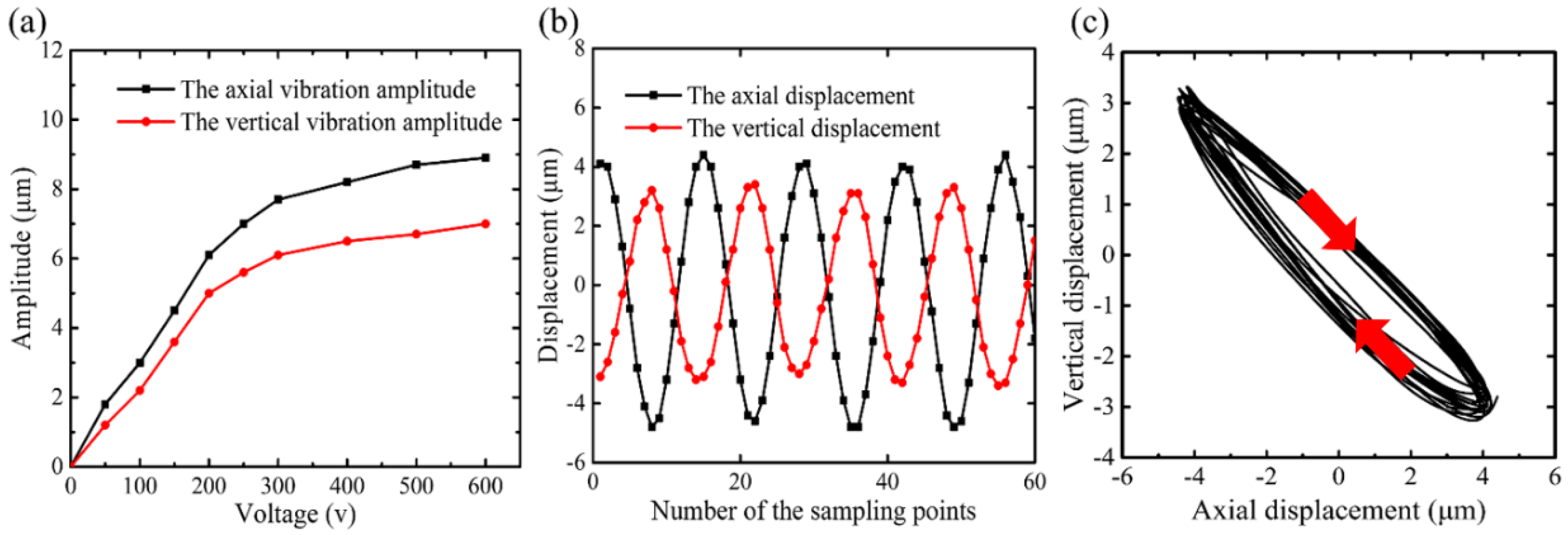
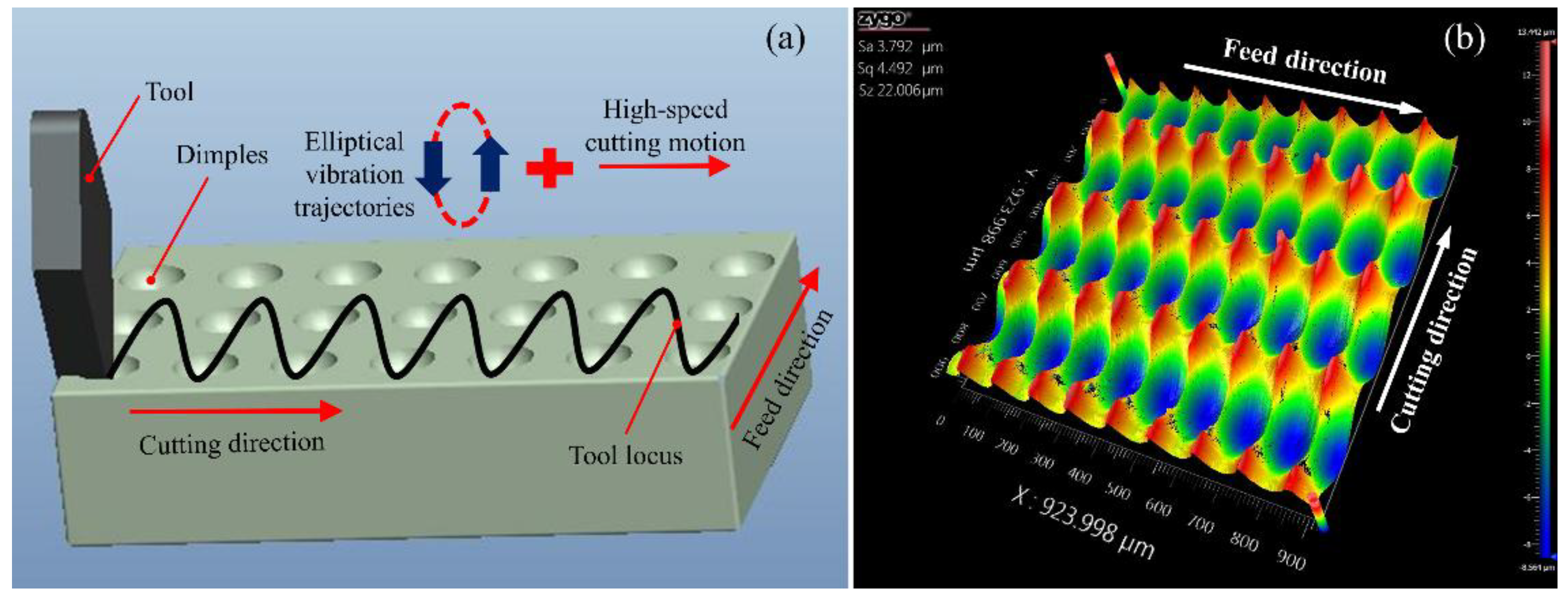
| Vibration conditions | Frequency (kHz) | 28.3 |
| Axial amplitude (μm) | 8.7 | |
| Vertical amplitude (μm) | 6.8 | |
| Cutting conditions | Nominal cutting speed (m/s) | 5.8 |
| Feed speed (μm/s) | 100 | |
| Nominal cutting depth (μm) | 2 | |
| Cutting tool | Material | SCD |
| Normal rake angle (°) | 0 | |
| Normal clearance angle (°) | 11 | |
| Nose radius (mm) | 0.2 |
© 2018 by the authors. Licensee MDPI, Basel, Switzerland. This article is an open access article distributed under the terms and conditions of the Creative Commons Attribution (CC BY) license (http://creativecommons.org/licenses/by/4.0/).
Share and Cite
Tan, R.; Zhao, X.; Zou, X.; Li, Z.; Hu, Z.; Zhang, W.; Sun, T. Design and Implementation of a Novel Single-Driven Ultrasonic Elliptical Vibration Assisted Cutting Device. Micromachines 2018, 9, 535. https://doi.org/10.3390/mi9100535
Tan R, Zhao X, Zou X, Li Z, Hu Z, Zhang W, Sun T. Design and Implementation of a Novel Single-Driven Ultrasonic Elliptical Vibration Assisted Cutting Device. Micromachines. 2018; 9(10):535. https://doi.org/10.3390/mi9100535
Chicago/Turabian StyleTan, Rongkai, Xuesen Zhao, Xicong Zou, Zengqiang Li, Zhenjiang Hu, Weipan Zhang, and Tao Sun. 2018. "Design and Implementation of a Novel Single-Driven Ultrasonic Elliptical Vibration Assisted Cutting Device" Micromachines 9, no. 10: 535. https://doi.org/10.3390/mi9100535





